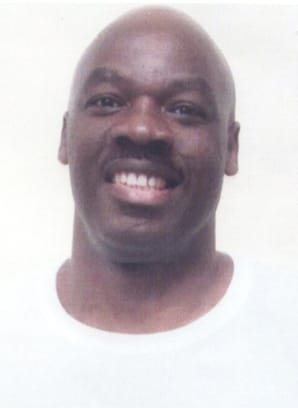by Mutope Duguma
In 1619, the first Africans were brought to North America by force to be slaves. From 1619 to 1776, this brutal chattel slave system was able to flourish in the 13 British colonies. From 1776, the United States government would take over the reins of this land, including its brutal slave system. From 1776 to 1865, while declaring its independence from its mother country, Great Britain, on July 4, 1776, the U.S. nevertheless held onto all of its evil practices.
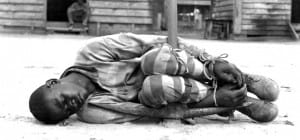
The so-called Emancipation Proclamation of 1863 would end slavery as we know it. At the end of the Civil War in 1865, these so-called freed slaves would be subjugated by a new system of exclusion and exploitation under the Black Codes. Instituted by the slave states as slave codes, the Black Codes effectively re-enslaved Black people identified as vagrants, replacing their freedom with forced labor.
After the brief period of Black involvement in government known as Reconstruction, from 1865 to 1877, Black freedom was also denied for almost 100 more years by legalized racial segregation under the Jim Crow laws. After winning their freedom in the bloodiest conflict in U.S. history, Blacks were in many cases and places denied basic human, civil and political rights: the right to vote, the right to employment, the right to freely move about, the right to own land, the right to education, the right to decent housing, the right to adequate food and clothing, the right to a fair and just judicial system and much more, literally forcing New Afrikans back into slavery by denying them a right to life. Jim Crow segregation in one form or another was practiced nationwide.
Pattern of practice
Our Afrikan ancestors were forced to make their own way, while being denied everything and subjected to vicious racist attacks by local, state and federal government officials. The state would use vagrancy laws in order to criminalize New Afrikans because they did not have a job. Unemployment was considered a violation of state law, although the same system shut them out of the job market.
Once they were convicted under the vagrancy laws, they would be off to the penitentiary, where they would be forced back into slavery, legally, under the 13th Amendment of the U.S. Constitution. So the government was able to use its judicial proceedings in order to incarcerate thousands of New Afrikans under these vagrancy and Jim Crow laws in order to force them back into free slave labor, which was the government’s objective.
Pattern of practice
The struggle for civil rights in this country can easily define what I mean by pattern of practice. The Civil Rights Act of 1866 was vetoed by President Andrew Johnson, but the law still passed. It was supposed to give New Afrikans citizenship and extensive civil rights for all men born in the United States, except “Native Indians.” The Enforcement Act of 1870 was passed to re-enact the Civil Rights Act of 1866 once the 14th Amendment made its enforcement unquestionably constitutional.
Much of the Civil Rights Act of 1871 was codified into federal law as Section 1983, but its influence waned as Reconstruction ended. Then the Civil Rights Act of 1875 was passed to outlaw discrimination in public places because of race or previous servitude. But in 1883, the act was declared unconstitutional by the U.S. Supreme Court, which stated that the 14th Amendment, the constitutional basis of the act, protected individual rights against infringement by the states, not by other individuals.
Pattern of practice
The Civil Rights Acts of 1957, 1960, 1964 and 1968 were basically testaments to the consistency of a resistance struggle for civil rights in this country by New Afrikans and the countless human beings who would join in this Civil and Human Rights Movement, yet the system would continue to interfere with and obstruct the human and civil rights of New Afrikans every step of the way for over 100 years. And today we are right back where we started, fighting for our human and civil rights.
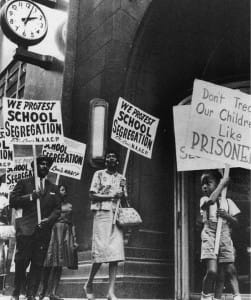
Pattern of practice
We very well could be fighting for our human and civil rights in this country as long as the Congress – the Senate and the House of Representatives – the legislative branch of the United States government, continues to deny New Afrikans our human and civil rights indefinitely. Government intransigence forces New Afrikans to address this issue every 20 years or so. This is where the real injustices occur, speaking to the real racist application of such pattern of practice. Throughout our struggle, the Civil Rights Movement was and is of astronomical value in our Resistance Movement.
Brief historical perspective
It would be counterproductive not to mention Denmark Vesey, Martin Delaney and especially Marcus Garvey and the contributions he and the United Negro Improvement Association (UNIA) made toward our struggle for independence, which nationalized us as a people, because that organization would be the catalyst for many freedom movements to come.
The civil and human rights organizations were all instrumental in laying a foundation for more progressive struggles that would take center stage in our struggle to be liberated, starting with the Nation of Islam (NOI), the Black Liberation Movement (BLM), which would give life to the Black Panther Party (BPP), Republic of New Afrika (RNA), Black Liberation Army (BLA) and countless other revolutionary formations that would become the face of the struggle for Black liberation, i.e., freedom in Amerika.
We must begin to see these Sistas and Bruthas as our honorable men and women who have made sacrifices and continue to stand in struggle, while always remembering those who made the ultimate sacrifice.
The New Afrikan Independence Movement (NAIM) would be established and our struggle continue for self-determination, enabling us to govern ourselves as a New Afrikan independent nation within the borders of Amerika. New Afrikans would attempt to mobilize our people around socio-cultural, political and economic principles that speak to our humanity as a people, bringing into focus an ideology that represents the core of our identity, life style and beliefs that’s inclusive of all humanity.
The civil and human rights organizations were all instrumental in laying a foundation for more progressive struggles that would take center stage in our struggle to be liberated.
These movements would progress until the mid-1970s , when state and federal governments made a concerted effort to stamp out all New Afrikan movements. Whether they were peaceful or radical, the government would conduct a vicious campaign, where the local, state and federal law enforcement agencies would work in conjunction to murder and incarcerate any New Afrikans who dared to fight for their basic humanity and right to self-determination.
These repressive attacks by the government jeopardized our political and ideological development as a people. The brutal suppression programs waged against our people put fear in many, and the struggle for freedom had to take a back seat. To some extent, fear took the fight out of the people.
Pattern of practice: Lost communities
This would open up the floodgates to the many street vices that would be introduced and unleashed on the New Afrikan communities: extreme poverty, drugs, alcohol, police, guns, etc., etc. – all weapons of mass destruction.
At the same time, New Afrikans would move toward re-assimilation into the fabric of Amerikan society, especially the professional New Afrikans, who could provide a service that could be exploited for the interests of corporate Amerika, not the people, and many abandoned their old neighborhoods. The more economically deprived the New Afrikan community was, the more desperate it became, and it is here where all sense of community would begin to be lost – where each individual would be trying to survive at the expense of everyone else, by any means necessary.
The generations to come, from 1975 to the present, would be left to their own devices, causing many to be compromised by the very vices just spoken to.
Pattern of practice: Weapons of mass destruction
In the 1950s, 1960s and 1970s, PCP pills and heroin were heavily pumped into our communities; in the 1980s and 1990s, it was PCP and crack cocaine; in the mid-1980s and 1990s, guns saturated our communities – every inner city ghetto and all the other residential areas largely populated by New Afrikans. Drive-by fast-food joints saturated the community, causing mass obesity; liquor stores saturated the community, causing addiction to a legal substance; toxic chemical plants saturated the community, causing all kinds of ailments. Militarized police departments saturated – and occupied – the community, murdering our children and people with impunity.
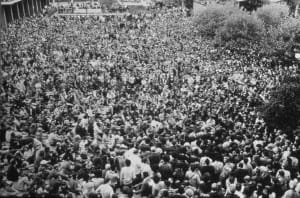
Over the years, the government declared and waged war on the New Afrikan communities: In the 1800s, it was a war on unemployed “vagrants,” where countless so-called newly freed slaves were incarcerated in order to re-enslave them under the 13th Amendment to the U.S. Constitution; in the 1970s and 1980s, it was a war on crime, and thousands of New Afrikans would be criminalized; in the 1980s and 1990s the war on drugs would be used to imprison New Afrikans at alarming rates, until 40-50 percent of the population of the prison industrial slave complex (PISC) would be New Afrikans; in the mid-1980s, 1990s and 2000s the war on gangs would be used to terrorize the New Afrikan communities, with battering rams, SWAT teams, gang injunctions, gentrification, illegal evictions and mass incarceration.
In the mid-1990s, the war on domestic terrorism would seal the fate of thousands of prisoners serving life sentences, when the then so-called first Black president, Bill Clinton, signed off on the Antiterrorism and Effective Death Penalty Act (AEDPA) that would subject thousands of poor New Afrikans to civil death.
These are all coded declarations of war on the New Afrikan people.
Pattern of practice: Economic deprivation
Government and corporate Amerika have been active participants in making sure that New Afrikans and their communities are economically deprived by refusing to keep up the property they own and control. The people who were born and raised in these communities have to watch their property values drop while they are not allowed to maintain or utilize those facilities for the interests of the community.
And when the people offer to purchase such desolate property, then the true intentions of the government and corporate owners are exposed. They attempt to hide behind some state or federal policy to explain why the property cannot be sold or given to the people to improve, or the corporate owners will attempt to place some huge, out-of-the-ordinary price on such desolate property that they have no use for, other than as an instrument to devalue the already struggling, economically deprived communities.
This is nothing but a scheme that’s been used for over a century to create poverty-stricken environments all over Amerika, especially in the New Afrikan communities.
Pattern of practice: Political prisoners
State and federal prisons hold the many New Afrikan political prisoners all over this country in solitary confinement units, where they are tortured by state and federal government workers for their political beliefs. We’re talking about the most educated of our people, kept in isolation for decades, with no end in sight for release from these state and federal torture chambers.
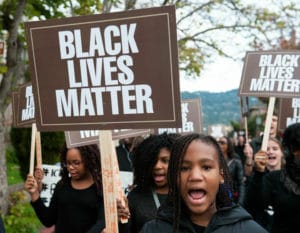
Many have dedicated their lives to helping improve our living conditions and empowering the people to control the socio-cultural, political and economic systems that ultimately dictate their lives. We must, as fellow humans, reach back to these men and women who have sacrificed so much.
Pattern of practice: Modern day slavery
The government deliberately calculated that building its prison industrial slave complex (PISC), which is humongous, throughout the United States in strategic areas would not only provide a surplus of modern day slaves. The new system of plantations would be welcomed into many dilapidated, economically deprived white, rural communities with its promise to create jobs – at the expense of other impoverished human beings – which has been a very clever way of laundering taxpayers’ money back into white communities. We’re talking about billions of dollars, if not trillions, over a period of time.
Pattern of practice: Main culprits
Corporate Amerika works hand in hand with the United States government against the New Afrkican community by using its institutions to carry out race and class warfare, by glamorizing on the television and in movies a malignant sub-culture that was to dehumanize, devalue, degrade and desensitize New Afrikans to the rest of the world, as well as ourselves – a marketing campaign toward our genocide. There has always been an indictment against New Afrikans in the U.S. by local, state and federal goverments that is implemented through policies and laws that can be tracked easily from 1619 to today.
The politicians who are the power brokers of this nation use the Black establishment, the Asian establishment, the Latino establishment etc. as willing participants in carrying out institutionalized racist policies that have been genocidal toward humanity.
Pattern of practice: Conclusion
There seems to be one thing that the Democrats, Republicans and Independent politicians can agree on unanimously, and that is the declaration of war against New Afrikan and other oppressed people, while depriving those humans of basic necessities, such as adequate educational institutions, adequate jobs, adequate housing, adequate food and clean water etc.
We, the people, have to address corporate and institutionalized racism if we are truly about social justice. It is the only way we can attempt to achieve something in respect to ending the prevalent injustices that plague us as humans.
One love, one struggle!
Mutope Duguma
Send our brother some love and light: Mutope Duguma, s/n James Crawford, D-05996, PBSP SHU D2-107, P.O. Box 7500, Crescent City CA 95532.





